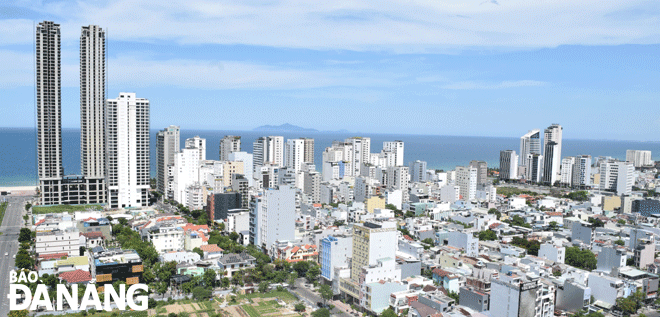Developing Da Nang urban in form of a multipolar structure
In its urban planning for 2021-2030 period, with a vision to 2050 approved by the provincial planning appraisal council under the Ministry of Planning and Investment on December 27, 2022, Da Nang’s urban structure will be developed in the direction of multipolarity.
 |
| The city plans to develop tourism in the direction of the whole city becoming a major tourist destination. IN THE PHOTO: A thriving areas of service and tourism facilities in Son Tra and Ngu Hanh Son districts. Photo: HOANG HIEP |
3 characteristic urban and 1 ecological areas
In his report about the city’s urban planning for the 2021-2030 period, with a vision to 2050, municipal People's Committee Vice Chairman Ho Ky Minh remarked that Da Nang will be developed with a multipolar urban structure with three characteristic urban and one ecological areas.
Accordingly, the three characteristic urban areas will be a waterside area along the east coast of the city and the Da Nang Bay, along local rivers organically connecting to districts of Lien Chieu, Son Tra, and Thanh Khe, Hai Chau and Ngu Hanh Son and a part of Cam Le District, and a coastal area connecting the coastline from Thua Thien Hue to Quang Nam provinces.
The green core area is organically connected to the districts of Lien Chieu, Thanh Khe, Hai Chau, Ngu Hanh Son and Cam Le and a part of Hoa Vang District.
The hillside area is organically connected between the areas of Hoa Vang District and other districts.
Meanwhile, the ecological area will include forests, mountains and hills to the west of the city, the Son Tra Peninsula and Hoang Sa District, rivers and lakes along with a long coastline in the eco-area.
The city will adjust the monocentric urban structure with only focus on Thanh Khe and Hai Chau districts into multi-polar development.
It also will add 4 priority job clusters to deploy multi-polar urban development. They will be a high-tech industrial cluster, a seaport and logistics cluster, a hi-tech agricultural cluster, and an innovation cluster.
At the same time, special attention will be paid to developing tourism in the direction of the whole city becoming a major tourist destination. The whole city will be organized into 19 urban areas in 12 subdivisions. The direction of new urban development is to develop to the west and northwest of the city.
By 2030, urbanized areas will be identified in 9 communes of Hoa Vang District, namely Hoa Khuong, Hoa Phuoc, Hoa Chau, Hoa Tien, Hoa Phong, Hoa Nhon, Hoa Lien, Hoa Son and a part of Hoa Ninh Commune with the urbanization rate of being over 90%.
Six inner urban districts of Lien Chieu, Thanh Khe, Hai Chau, Son Tra, Cam Le and Ngu Hanh Son will be oriented to be redeveloped according to the compact urban model, thereby reducing construction density in the existing central city, improving the land use coefficient, adding urban utilities, and integrating with the public transport system.
Furthermore, modern-style architectural works will be developed, creating the attraction of a modern central business district (CBD) center and improving high quality of life.
Existing urban areas with lower population densities than core areas will develop with higher population densities and construction densities in accordance with regulations. Public green spaces in residential areas will be built, whilst an integrated transport system with the city-wide public transport network will be developed.
The city is oriented to build a system of underground space at public works, services, high-rise buildings, key intersections, stations, and urban railway lines, connected to underground parking lots and traffic tunnels in a bid to form a complete, multi-purpose underground space.
Investment in urban infrastructure construction
Speaking at the planning appraisal meeting on December 27, 2022 in Ha Noi, Mr. Nguyen Duc Minh from the Department of Planning and Architecture under the Ministry of Construction, noted that, according to the adjusted master plan for the Da Nang development to 2030, with a vision to 2045 approved by the Prime Minister, Singapore's consulting unit has the idea of expanding population in the city center to hillside subdivisions.
However, in the Da Nang urban planning for the 2021-2030 period, with a vision to 2050, the city has more ‘compression’ in the central area to increase land use efficiency. This will be a pressure and difficulty for technical and social infrastructure, so the city needs to research and supplement urban infrastructure.
According to the Da Nang Department of Construction, the city sets a goal by 2030 that the ratio of urban construction land to the total natural land area ( excluding Hoang Sa island district) will reach about 32%; and the ratio of static traffic land compared to urban construction land 3-4%.
Besides, the average urban green land area for public use per urban dweller will be 9m2, whilst the average residential floor area per capita in urban areas will be at least 32m2.
Reporting HOANG HIEP - Translating by M.DUNG